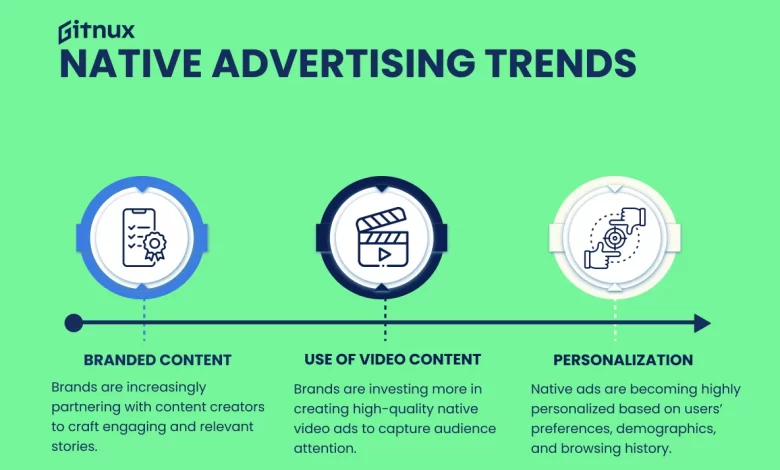Increased Demand for Native Advertising: Exploring the Trend

Native advertising is a type of advertising that is designed to blend in with the content of the platform it appears on, making it less intrusive and more engaging for the audience. In recent years, there has been a significant increase in demand for native advertising, with spending on native ads projected to reach $98.59 billion in 2023 in the US alone. This trend is expected to continue as more businesses recognize the effectiveness of native advertising in engaging audiences and driving conversions.
Understanding Native Advertising Native advertising is a form of paid media that is seamlessly integrated into the user experience of a platform, making it appear more like organic content rather than an ad. This type of advertising is often used by businesses to promote their products or services in a way that feels more natural and less intrusive to the audience. Native ads can take many forms, including sponsored content, in-feed ads, and recommended content.
Rising Demand for Native Advertising The rise of native advertising can be attributed to several factors, including the decline in the effectiveness of traditional advertising methods such as banner ads and pop-ups. As consumers become more immune to these types of ads, businesses are turning to native advertising as a way to reach their target audience in a more engaging and effective way. Additionally, the rise of mobile devices and social media platforms has created new opportunities for native advertising, as these platforms are well-suited to this type of advertising.
Key Takeaways
- Native advertising is a type of advertising that blends in with the content of the platform it appears on, making it less intrusive and more engaging for the audience.
- The demand for native advertising is on the rise, with spending on native ads projected to reach $98.59 billion in 2023 in the US alone.
- The rise of native advertising can be attributed to several factors, including the decline in the effectiveness of traditional advertising methods and the rise of mobile devices and social media platforms.
Understanding Native Advertising
Definition of Native Advertising
Native advertising is a type of advertising that is designed to blend in with the editorial content of a website or publication. It is a form of paid media that is created to match the form and function of the platform on which it appears, making it less disruptive and more engaging for the viewer. Native ads can be found on social media platforms, news websites, and other online publications.
Native advertising can take many forms, including sponsored content, product placement, and branded content. Sponsored content is content that is created by a company or brand and promoted on a website or social media platform. Product placement is when a product is featured in a piece of content, such as a video or a blog post. Branded content is content that is created by a publisher or influencer and sponsored by a brand.
Importance of Native Advertising
Native advertising is becoming more important for brands and publishers as consumers become more aware of traditional advertising methods, such as banner ads and pop-ups. Native ads are less intrusive and more engaging, which makes them more effective at reaching consumers.
According to a study by Outbrain, native ads receive 53% more views than traditional display ads, and they generate 18% more purchase intent. Native ads are also more likely to be shared than traditional ads, which can help increase brand awareness and reach.
Native advertising is also important for publishers, as it allows them to monetize their content without disrupting the user experience. By creating sponsored content that fits seamlessly into their editorial content, publishers can provide a more valuable experience for their readers while still generating revenue.
Overall, native advertising is a valuable tool for brands and publishers alike. By creating ads that are less disruptive and more engaging, they can reach consumers more effectively and provide a better user experience.
Rising Demand for Native Advertising
Native advertising has become increasingly popular in recent years due to its ability to blend seamlessly into the content of a website or social media platform. This form of advertising has grown in popularity due to its ability to provide a more natural and less intrusive advertising experience for consumers. As a result, businesses are investing more in native advertising to reach their target audiences.
Current Market Trends
According to Insider Intelligence, native video advertising is expected to make up 84.1% of all video ad spend in the US by 2022. This represents an increase of nearly 2% compared to 2021. In contrast, social video spending is expected to drop by over 2.5% compared to last year. This trend is expected to continue as businesses seek to create more engaging and relevant content for their audiences.
Native advertising has also become a top-performing video ad format for US brands and publishers. According to Taboola, native ads with no text in their images drive higher click-through rates (CTRs) than those with text. Additionally, the global native ad market is expected to be worth $400 billion by 2025, according to Adflex.
Future Projections
As businesses continue to invest more in native advertising, the trend is expected to continue to grow. According to VentureBeat, native ad spending has increased by 600% from 2014 to 2016 across all verticals. This growth is expected to continue as businesses seek to create more engaging and relevant content for their audiences.
In the ever-evolving world of digital marketing, staying ahead of the game is crucial for businesses seeking to capture the attention of their target audience. Native advertising is leading the charge in shaping the future of advertising. With its ability to provide a more natural and less intrusive advertising experience for consumers, it is expected to continue to grow in popularity in the coming years.
Factors Driving the Demand
Native advertising has become an increasingly popular form of advertising in recent years. There are several factors driving the demand for native advertising, including changes in consumer behaviour, the digital transformation of the advertising industry, and the adoption of new content marketing strategies.
Consumer Behavior
One of the key drivers of the increased demand for native advertising is changes in consumer behaviour. Consumers are becoming more selective about the content they consume, and are increasingly turning to ad-blocking software to avoid traditional forms of advertising. As a result, native advertising has emerged as an effective way for advertisers to reach consumers with relevant and engaging content that doesn’t feel like advertising.
Studies have shown that consumers are more likely to engage with native ads than with traditional banner ads. Native ads are also less likely to be blocked by ad-blockers, making them a more reliable way for advertisers to reach their target audience.
Digital Transformation
The digital transformation of the advertising industry is another key driver of the increased demand for native advertising. As more and more consumers move online, advertisers are looking for new ways to reach them. Native advertising offers a way for advertisers to deliver relevant content to consumers in a format that is native to the platform they are using.
The rise of programmatic advertising has also contributed to the growth of native advertising. Programmatic advertising allows advertisers to target specific audiences with relevant content, making it easier to deliver effective native advertising campaigns.
Content Marketing Strategies
Finally, the adoption of new content marketing strategies is driving the demand for native advertising. Content marketing has become an increasingly important part of the marketing mix, with many brands using content to engage with consumers and build brand awareness.
Native advertising offers a way for brands to incorporate their content into the user experience, making it more likely that consumers will engage with it. By delivering relevant content in a format that is native to the platform, brands can build trust and credibility with their target audience, ultimately driving conversions and sales.
In summary, changes in consumer behaviour, the digital transformation of the advertising industry, and the adoption of new content marketing strategies are all driving the increased demand for native advertising. As advertisers look for new ways to reach consumers in a crowded and competitive marketplace, native advertising offers a powerful tool for delivering relevant and engaging content that resonates with target audiences.
Impact on Businesses
Native advertising has been on the rise in recent years with businesses utilizing this marketing strategy to reach their target audience. This trend is expected to continue in the coming years, with businesses of all sizes incorporating native advertising into their marketing mix. In this section, we will explore the impact of increased demand for native advertising on businesses.
Marketing Strategies
Native advertising has become an essential component of marketing strategies for businesses. With the rise of ad-blocking software and the increasing number of consumers who are resistant to traditional advertising, businesses need to find new ways to reach their target audience. Native advertising offers a less intrusive way of advertising by blending in with the content that the consumer is already consuming. This approach helps businesses to create a more engaging and personalized experience for their audience.
Businesses can use native advertising to promote their products or services, build brand awareness, and drive traffic to their website. By creating high-quality content that resonates with their target audience, businesses can establish themselves as thought leaders in their industry and build trust with their customers.
Business Growth
The increased demand for native advertising has created new opportunities for businesses to grow and expand their reach. By leveraging native advertising, businesses can reach new audiences and expand their customer base. This can lead to increased revenue and a better return on investment (ROI) for their marketing efforts.
In addition, native advertising allows businesses to target specific demographics and interests, ensuring that their message reaches the right people. This targeted approach can help businesses to improve their conversion rates and generate more leads.
Overall, the impact of increased demand for native advertising on businesses is significant. By incorporating native advertising into their marketing strategies, businesses can create engaging content that resonates with their target audience, build brand awareness, and drive growth.
Challenges and Solutions
Ad-Blocking
One major challenge that native advertising faces is ad-blocking. With the rise of ad-blockers, many internet users are not seeing native ads and are therefore not engaging with them. This can be a significant problem for advertisers who rely on native ads to reach their target audience.
One solution to this challenge is to create more engaging and relevant content that users will want to engage with. By creating content that is informative, entertaining, and useful, advertisers can increase the chances that users will want to engage with their native ads. Additionally, advertisers can work with publishers to create native ads that are less intrusive and more integrated into the user experience, which can also help to reduce the impact of ad blocking.
Transparency Issues
Another challenge that native advertising faces is transparency. Many users are not aware that they are viewing native ads, which can lead to a lack of trust and a negative perception of native advertising. This lack of transparency can also lead to legal issues for advertisers who are not properly disclosing that their content is sponsored.
To address this challenge, advertisers can work to increase transparency by clearly labelling their native ads as sponsored content. Additionally, advertisers can work with publishers to ensure that their native ads are clearly identified as sponsored content and that users are aware that they are viewing ads.
Solutions to Challenges
To overcome these challenges, advertisers can work to create more engaging and relevant content, work with publishers to create less intrusive ads, and increase transparency by clearly labelling their sponsored content. By taking these steps, advertisers can increase the effectiveness of their native ads and reach a wider audience.
| Challenges | Solutions |
|---|---|
| Ad-Blocking | Create engaging content, work with publishers to create less intrusive ads |
| Transparency Issues | Clearly label sponsored content, work with publishers to ensure transparency |
Conclusion
Native advertising has been on the rise in recent years, and the trend is expected to continue in the coming years. As consumers become more savvy and traditional advertising methods lose their impact, native advertising has emerged as a powerful way to capture attention and increase engagement.
According to a study by Outbrain, native video advertising is forecast to comprise 84.1% of all video ad spend in the US, an increase of nearly 2% compared to 2021. This is in contrast to social video spending, which is expected to drop by over 2.5% compared to last year.
Moreover, a research paper suggests that digital native advertising is a subtle form of digital advertising that is integrated closely with its context. Practitioners are increasingly assigning budgets to this advertising strategy.
Native advertising is a method of creating and distributing paid ads that match the look and feel of the surrounding content. It is a non-disruptive way to advertise and is often seen as a more ethical approach to advertising.
As the demand for native advertising continues to grow, it is important for advertisers to understand how to create effective native ads that resonate with their target audience. By creating ads that are relevant, engaging, and informative, advertisers can increase their chances of success with native advertising.
In summary, native advertising is a powerful tool for advertisers looking to increase engagement with their target audience. With the rise of ad blockers and the decline of traditional advertising methods, native advertising is expected to become even more important in the coming years. Advertisers who can create effective native ads that resonate with their target audience will be well-positioned to succeed in this new advertising landscape.
Frequently Asked Questions
How does native advertising work?
Native advertising is a form of online advertising that blends in with the surrounding content. It is designed to look and feel like the editorial content on a website or social media platform, making it less intrusive and more engaging for the user. Native ads can take many forms, such as sponsored articles, videos, and social media posts.
What are the benefits of using programmatic native ads?
Programmatic native advertising allows advertisers to use data and technology to automate the buying and selling of native ads. This can lead to more efficient and effective ad campaigns, as programmatic ads can be targeted to specific audiences and optimized in real time. Programmatic native ads can also be scaled across multiple platforms, making it easier to reach a larger audience.
What are some examples of successful native social ads?
Some successful examples of native social ads include Airbnb’s “Live There” campaign on Instagram, which featured user-generated content and reached over 44 million people, and GE’s “Invention Donkey” campaign on BuzzFeed, which generated over 700,000 views and 11,000 social shares.
How does native advertising compare to traditional display ads on websites?
Native advertising is generally considered to be more effective than traditional display ads, as it is less intrusive and more engaging for the user. Native ads are also more likely to be viewed and clicked on, as they are integrated into the content rather than appearing as separate ads on the page.
What are the latest statistics on the effectiveness of native advertising in 2022?
According to a report by eMarketer, native advertising is expected to account for 62.7% of all digital display ad spending in the US in 2022. Additionally, a study by Sharethrough and IPG Media Lab found that native ads are viewed 53% more frequently than traditional display ads and drive 18% higher purchase intent.
Where are consumers most likely to encounter native advertising?
Consumers are most likely to encounter native advertising on social media platforms, such as Facebook, Instagram, and Twitter, as well as on news and media websites. Native ads are also becoming more prevalent on mobile devices, as they are better suited to the smaller screen size and more interactive nature of mobile content.





